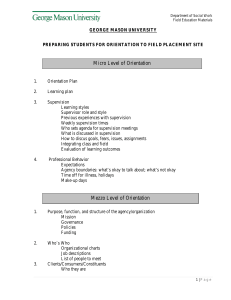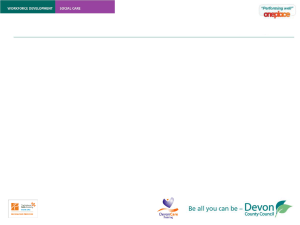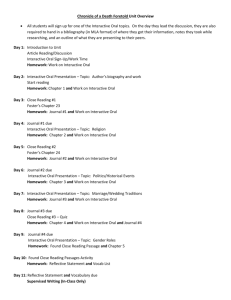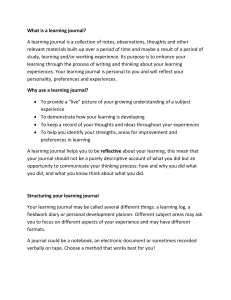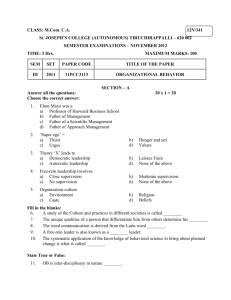Psychoanalytic Theory
advertisement
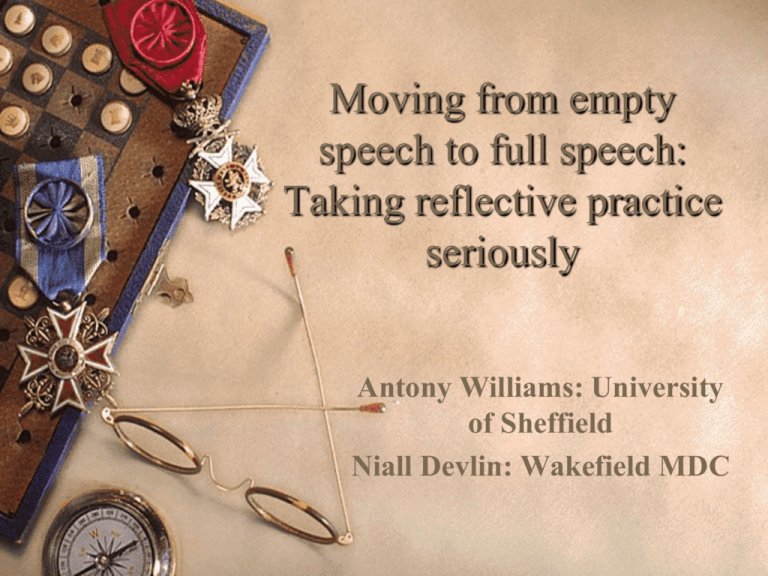
Moving from empty speech to full speech: Taking reflective practice seriously Antony Williams: University of Sheffield Niall Devlin: Wakefield MDC Focus of the session 1. Briefly situate the development of reflective practice. 2. Discuss professional supervision as a site for reflective practice. 3. Introduce the concepts of empty and full speech. 4. Discuss their relevance to supervision as a site of reflective practice. 5. To provide a theoretical framework with which to examine the link between reflective practice and professional identity. The Historical raise of pastoral roles The growth in the pastoral role of the state was a 20th century western phenomenon. Along with increasing urbanisation developed a number of professions with the remit for managing and caring for the population, ensuring and promoting wellbeing, along with the maintenance of the state. Roles within Education, Health and Social Care Reflective practice within pastoral work Early work by Dewey, then the work of Schon, reflected cultural changes that demanded an increasingly reflective stance. ‘Genuine knowledge not just doing or considering abstractly but through integrating thinking and doing, by getting the mind to reflect on the act’ – Dewey in Gordon, 2009, p.49 Supervision as reflective practice The organastional structured space to support and develop the reflective mind. Two person or group reflective practices are most often conceptualised and operationalised as clinical supervision in the professional practice of the helping professions (Scaife, 2009). A question of definitions? Definitions of supervision in clinical practice are premised on an understanding that they increase competence (Loganbill et al, 1982, p.4); act as a form of education and training (Falender and Shafranske, 2004, p.3) and ‘perform the functions of education, support and evaluation against the norms and standards of the profession and society’ (Scaife, 2009, p.3) A contested space Conceptualisations of supervision have differed between cultures and professions, giving rise to the proposition that supervision ‘is not a uniformed corpus but a conflicted site’ (Davy, 2002, p. 228) Reflective and managerial origins Supervision has origin in managerial practice concerned with standards and measures of effectiveness (Page and Wosket, 1994). ‘Professional supervision’ was originally practised in the 1920s by psychoanalytic practitioners in order to review each other’s work (Carroll, 1996). The professional context "Supervision is what happens when people who work in the helping professions make a formal arrangement to think with another or others about their work with a view to providing the best possible services to clients, enhancing their own personal and professional development and gaining support in relation to the emotional demands of the work. " Source: Joyce Scaife 14th June 2002 University of Sheffield “We maintain a separation between managerial and casework supervision.” Context: Professional discourse Focused on examining discourse between two professional practitioners reflecting on their professional practice, the type of organisationally based professional talk which is the expected stuff of formal reflective practice processes – i.e. Peer supervision. All relationships provide opportunities for emotional - identity work (parent-child, teacher, child, EP-Client). The identity work is both offered by the emotional work and produces emotional work. Peer supervision is both one such relationship and a way to work through the identity and emotional work provided by other professional relationships. The emotional and identity work is offered by processes that: – creates images of a unified, integrated and stable self in the self/other. – creates an imaginary self/other structured by an understanding of how we believe others see us or wish us to be. The focus in using a psychoanalytic framework is to explore the structure of the text and also explore how the (con)text structures the speaking subjects. Through the application of a Lacanian Discourse Analysis to the text, key one Lacanian concept stood out as relevant. We would like to: Introduce the concepts Discuss the concepts relevance Roots of key concept Lacan draws on Heidegger’s distinction between Rede (discourse) and Gerede (chatter) to elabarate his notion of full and empty speech (1953 -1955) Lacan’s topology of the mind Full speech Speech which is considered full aims at and forms the truth such as it becomes established in recognition of one person by another. (Lacan, 1970-71) By speaking to herself, the subject is transformed into someone else. Through her ‘full speech which performs’ she finds herself, afterwards other than she was before’ Characteresied by: i. Fragmented, dislocated and fleeting discourse ii. Inconsistency, incoherency of narrative iii. The struggle to represent ourselves in speech Empty speech Empty speech the subject seems to be talking in vain about someone who can never become one with the assumption of his desire. Characterised by Speech which creates images of a unified, integrated and stable self. ii. The creation of an imaginary self structured by an understanding of how we believe others see us or wish us to be. i. In full speech we learn to acknowledge the interplay between us as particular individuals and the universal order that constitutes and constrains this individuality. We can recognise that as unique subjects we are not only fragments of a transindividual order but a creative force that continues to rupture and dislocate this order. Emergent methodology Originally data/text recorded to support a project focused on reflecting on a joint practice experience. A way of reflecting on our experience of the event . Afterward became increasingly interested in the actual point of reflection, rather than the topic/focus of the reflection, this led to ........ 1 The concepts of full and empty speech appeared apt descriptors for shifts in the text. Inconsistancies appeared to speak to a selfpositioning and practitioner identities work. ‘Human language for Lacan... Makes possible ‘communication in which the sender receives his own message back from the receiver in an inverted form’ (Parker, 2005, p.174) 2 ‘The real is not the realm ‘outside’ discourse that can be identified and described, but is something that operates at a point of breakdown of representation at a point of trauma or shock that is then rapidly covered over’ Parker, 2005, p.176 Emergent through the analysis Analysis of text revealed: – Disagreement – Discontinuities in discourse, p.21, p.35, misuse of ‘I’ just before discontinuity. – Disavowal of difference, coming together to cover up differing positions. – Continually shifting shared signifies e.g. ‘those children’, ‘impossible children’ In our supervision we moved between full and empty talk as we moved from the imaginary and symbolic relationship with the imagined others. The utility of a Lacanian lens is to provide a tool to explore both the identity/emotional work and as a mirror to professional roles/practices that facilitated the work. The power of reflective practice This is not me anymore, but the text is me speaking, another probing and me responding. I was making meaning, speaking and listening and in the interplay of metaphor and metonymy, the me who heard me, was no longer quite the same me as the one who spoke me. Ways forward? In the local context concepts of empty and full speech may: Be helpful in thinking about the constructive process inherent in reflection, in training and in professional practice. Highlight the need for reflective spaces that are apart from mechanisms of accountability. Illuminate how supervision may be used as an opportunity to enhance the potential for self-determination and an understanding of the practitioner in their practice. Caution A process that is not for everybody, but may be an important opportunity for some. Key references Carroll, M. (1996). Counselling Supervision:Theory, Skills and Practice. London: Cassell. Driver, M. (2005).From empty speech to full speech? Reconceptualising spirituality in organisations based on a psychoanalytically-grounded understanding of the self. Human Relations 58: 1091-1110. Gordon, M. (2009). Towards a pragmatic discourse of constructivism: reflections on lessons from practice. Educational Studies, 45, 39-58. Parker, I. (2005). Lacanian discourse analysis in psychology: Seven theoretical elements. Theory and Psychology, 15, 163-182. Page, S. and Wosket, V. (1994) Supervising the Counsellor. A cyclical model, London: Routledge. Scaife, J. (2009). Supervision in clinical practice: A practitioner´s guide. (2nd edition). London: Brunner-Routledge.

